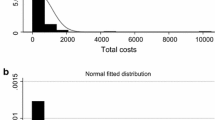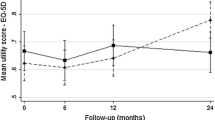Abstract
Achieving comprehensive patient centricity in cost-effectiveness analyses (CEAs) requires a statistical approach that accounts for patients’ preferences and clinical and demographic characteristics. Increased availability and accessibility of patient-level health-related utility data from clinical trials or observational database provide enhanced opportunities to conduct more patient-centered CEA. Regression-based approaches that incorporate patient-level data hold great promise for enhancing CEAs to be more patient centered; this paper provides guidance regarding two CEA approaches that apply regression-based approaches utilizing patient-level health-related utility and costs data. The first approach utilizes patient-reported preferences to determine patient-specific utility. This approach evaluates how individuals’ unique clinical and demographic factors affect their utility and cost levels over the course of treatment. The underlying motivation of this approach is to produce CEA estimates that reflect patient-level utilities and costs while adjusting for socio-demographic and clinical factors to aid patient-centered coverage and treatment decision-making. In the second approach, patient utilities are estimated based on the clinically defined health states through which a patient may transition throughout the course of treatment. While this approach is grounded on the widely used Markov transition model, we refine the model to facilitate an enhancement in conducting regression-based analysis to achieve transparent understanding of differences in utilities and costs across diverse patient populations. We discuss the unique statistical challenges of each approach and describe how these analytical strategies are related to non-regression-based models in health services research.
Similar content being viewed by others
References
Sabik LM, Lie RK. Priority setting in health care: lessons from the experiences of eight countries. Int J Equity Health. 2008;7:4.
Kearns B, Ara R, Wailoo A. A review of the use of statistical regression models to inform cost effectiveness analyses within the NICE Technology Appraisals programme. Sheffield: Decision Support Unit, ScHARR, University of Sheffield; 2012.
Stirling B, Sofaer S, Siegelberg T, Gold M. Has the time come for cost-effectiveness analysis in US health care? Health Econ Policy Law. 2009;4:425–43.
Garrison LP. Cost-effectiveness and clinical practice guidelines: have we reached a tip** point?—An overview. Value Health. 2016;19:512–5.
Russell L. The science of making better decisions about health: cost-effectiveness and cost-benefit analysis. Rockville: Agency for Healthcare Research and Quality; 2015.
Tan-Torres Edejer T, Baltussen R, Adam T, Hutubessy A, Acharya A, Evans DB, et al., editors. Making choices in health: WHO guide to cost-effectiveness analysis. Geneva: World Health Organization; 2003.
Brennan A, Chick SE, Davies R. A taxonomy of model structures for economic evaluation of health technologies. Health Econ. 2006;1310:1295–310.
Neumann PJ, Sanders GD, Russell LB, Siegel JE, Ganiats TG, editors. Cost-effectiveness in health and medicine. 2nd ed. Oxford: Oxford University Press; 2016.
Ramsey SD, Willke RJ, Glick H, Reed SD, Augustovski F, Jonsson B, et al. Cost-effectiveness analysis alongside clinical trials II—an ISPOR Good Research Practices Task Force report. Value Health. 2015;18:161–72.
Husereau D, Drummond M, Petrou S, Carswell C, Moher D, Greenberg D, et al. Consolidated Health Economic Evaluation Reporting Standards (CHEERS)—explanation and elaboration: a report of the ISPOR Health Economic Evaluation Publication Guidelines Good Reporting Practices Task Force. Value Health. 2013;16:231–50.
Ramsey S, Willke R, Briggs A, Brown R, Buxton M, Chawla A, et al. Good research practices for cost-effectiveness analysis alongside clinical trials: the ISPOR RCT-CEA Task Force Report. Value Health. 2005;8:521–33.
Johnson ML, Crown W, Martin BC, Dormuth CR, Siebert U. Good research practices for comparative effectiveness research: analytic methods to improve causal inference from nonrandomized studies of treatment effects using secondary data sources: the ISPOR Good Research Practices for Retrospective Database Analysis Task Force Report—part III. Value Health. 2009;12:1062–73.
Wailoo AJ, Hernandez-Alava M, Manca A, Mejia A, Ray J, Crawford B, et al. Map** to estimate health-state utility from non-preference-based outcome measures: an ISPOR Good Practices for Outcomes Research Task Force Report. Value Health. 2017;20(1):18–27.
Garrison LP, Neumann PJ, Erickson P, Marshall D, Mullins CD. Using real-world data for coverage and payment decisions: the ISPOR Real-World Data Task Force report. Value Health. 2007;10:326–35.
Sculpher MJ, Claxton K, Drummond M, McCabe C. Whither trial-based economic evaluation for health care decision making? Health Econ. 2006;15:677–87.
NIH. SEER-Medicare: brief description of the SEER-Medicare Database. 2016. https://healthcaredelivery.cancer.gov/seermedicare/overview/. Accessed 10 Oct 2016.
Lorgelly PK, Doble B, Knott RJ, Cancer T. Realising the value of linked data to health economic analyses of cancer care: a case study of Cancer 2015. Pharmacoeconomics. 2016;34:139–54.
Hardy M, Bryman A, editors. Handbook of data analysis. 1st ed. London: SAGE Publications; 2009.
Hoch JS, Briggs AH, Willan AR. Something old, something new, something borrowed, something blue: a framework for the marriage of health econometrics and cost-effectiveness analysis. Health Econ. 2002;11:415–30.
Willan AR, Briggs AH, Hoch JS. Regression methods for covariate adjustment and subgroup analysis for non-censored cost-effectiveness data. Health Econ. 2004;13:461–75.
Manning WG. The logged dependent variable, heteroscedasticity, and the retransformation problem. J Health Econ. 1998;17:283–95.
Lohr KN. Comparative effectiveness research methods: symposium overview and summary. Med Care. 2010;48:S3–6.
Horn SD, Gassaway J. Practice-based evidence study design for comparative effectiveness research. Med Care. 2007;45:S50–7.
Horn SD, Gassaway J. Practice based evidence: incorporating clinical heterogeneity and patient-reported outcomes for comparative effectiveness research. Med Care. 2010;48:S17–22.
Gold M, Siegel JE, Russell LB, Weinstein MC, editors. Cost-effectiveness in health and medicine. 1st ed. Oxford: Oxford University Press; 1996.
Feeny D, Krahn M, Prosser L, Salomon J. Valuing health outcomes. In: Newmann PJ, Sanders GD, Russell LB, Siegel JE, Ganiats TG, editors. Cost-effectiveness in health and medicine. 2nd ed. Oxford: Oxford University Press; 2017. p. 167–99.
Wolowacz SE, Briggs A, Belozeroff V, Clarke P, Doward L, Goeree R, et al. ISPOR Task Force report estimating health-state utility for economic models in clinical studies: an ISPOR Good Research Practices Task Force report. Value Health. 2016;19:704–19.
Dolan P, Roberts J. Modelling valuations for Eq-5d health states: an alternative model using differences in valuations. Med Care. 2002;40(5):442–6.
Briggs AH, Weinstein MC, Fenwick EAL, Karnon J, Sculpher MJ. Paltiel AD; ISPOR-SMDM Modeling Good Research Practices Task Force. Model parameter estimation and uncertainty: a report of the ISPOR-SMDM Modeling Good Research Practices Task Force-6. Value Health. 2012;15:835–42.
McMahon L, Newbold R. Variation in resource use within diagnosis-related groups: the effect of severity of illness and physician practice. Med Care. 1986;24:388–97.
Lo T, Parkinson L, Cunich M, Byles J. Factors associated with higher healthcare costs in individuals living with arthritis: evidence from the quantile regression approach. Expert Rev Pharmacoecon Outcomes Res. 2015;15:833–41.
Furlong W, Feeny D, Torrance GW, Barr RD, Horsman J. Guide to design and development of health-state utility instrumentation. CHEPA Working Paper 90-9. Hamilton: McMaster University Centre for Health Economics and Policy Analysis; 1990.
Basu A, Rathouz PJ. Estimating marginal and incremental effects on health outcomes using flexible link and variance function models. Biostatistics. 2005;6:93–109.
Basu A, Manning WG. Issues for the next generation of health care cost analyses. Med Care. 2009;47:S109–14.
McCabe C, Dixon S. Testing the validity of cost-effectiveness models. Pharmacoeconomics. 2000;17:501–13.
Hanley JA, Negassa A, deB Edwardes MD, Forrester JE. Statistical analysis of correlated data using generalized estimating equations: an orientation. Am J Epidemiol. 2003;157:364–75.
Basu A. Extended generalized linear models: simultaneous estimation of flexible link and variance functions. Stata J. 2007;5:501–16.
Stillman S. Review of generalized estimating equations by Hardin and Hilbe. Stata J. 2003;3:208–10.
Hardin JW, Hilbe J. Generalized estimating equations. Boca Raton: Chapman & Hall/CRC; 2003.
Putter H, Fiocco M, Geskus RB. Tutorial in biostatistics: competing risks and multi-state models. Stat Med. 2007;26:2389–430.
Whitehead SJ, Ali S. Health outcomes in economic evaluation: the QALY and utilities. Br Med Bull. 2010;96:5–21.
Drummond M, Sculpher MJ, Torrance G, O’Brien B, Stoddart G. Methods for the economic evaluation of health care programmes. 3rd ed. Oxford: Oxford University Press; 2005.
Fenwick E, Briggs A. Cost-effectiveness analysis. In: Melnick E, Everitt B, editors. Encyclopedia of quantitative risk analysis and assessment. Hoboken: John Wiley & Sons Ltd; 2008. p. 375–87.
Liu L. Joint modeling longitudinal semi-continuous data and survival, with application to longitudinal medical cost data. Stata Med. 2009;28:972–86.
Verbeke G, Molenberghs G. Linear mixed models for longitudinal data. New York: Springer; 2000.
Berger ML, Mamdani M, Atkins D, Johnson ML. Good research practices for comparative effectiveness research: defining, reporting and interpreting nonrandomized studies of treatment effects using secondary data sources: the ISPOR Good Research Practices for Retrospective Database Analysis Task Force Report—part I. Value Health. 2009;12:1044–53.
Brookhart M, Sturmer T, Glynn R, Rassen J, Schneeweiss S. Confounding control in healthcare database research: challenges and potential approaches. Med Care. 2010;48:114–20.
Jones AM, Lomas J, Moore PT, Rice N. A quasi-Monte-Carlo comparison of parametric and semiparametric regression methods for heavy-tailed and non-normal data: an application to healthcare costs. J R Stat Soc Ser A. 2016;179:951–74.
Lunceford JK, Davidian M. Stratiÿcation and weighting via the propensity score in estimation of causal treatment effects: a comparative study. Stat Med. 2004;23:2937–60.
Newhouse J, McClellan M. Econometrics in outcomes research: the use of instrumental variables. Annu Rev Public Health. 1998;19:17–34.
Bell ML, Fairclough DL. Practical and statistical issues in missing data for longitudinal patient-reported outcomes. Stat Methods Med Res. 2014;23:440–59.
Small CG, Wang J. Numerical methods for nonlinear estimating equations. Oxford: Oxford University Press; 2003.
Acknowledgements
This study was funded by Novartis AG. The authors would like to thank Kimberly Yang and Katherine Downton of the University of Maryland Health Sciences and Human Services Library for their assistance with the literature review, and Stephane Regnier at Novartis AG for his review of the manuscript.
Author information
Authors and Affiliations
Contributions
DG, YCTS, PL, MO, and CDM drafted the mathematical models with input from CU and YP. DG, CU, and YP conducted the literature review with input from YCTS, PL, MO, and CDM. DG, YCTS, and CDM wrote the manuscript with input from MO, PL, CU, and YP. All authors contributed equally to the review and editing of this manuscript.
Corresponding author
Ethics declarations
Funding
This study was author-initiated and funded by Novartis International AG.
Conflict of interest
C. Daniel Mullins and Daisuke Goto received research funding from Novartis International AG. Ya-Chen Tina Shih served as a paid consultant to the University of Maryland on a grant funded by Novartis International AG for work related to this manuscript. Pascal Lecomte and Melvin Olson are employees of Novartis International AG. Yu** Park is an employee of Novartis Pharmaceutical Corp. in the USA Chukwukadibia Udeze has nothing to disclose.
Overall guarantor
Daisuke Goto serves as overall guarantor for this study and article.
Ethical approval
This is a guidance document and formal consent is not required. Therefore, we did not submit our study to an independent ethics committee or institutional review board. This article does not contain any studies with human participants or animals performed by any of the authors.
Rights and permissions
About this article
Cite this article
Goto, D., Shih, YC.T., Lecomte, P. et al. Regression-Based Approaches to Patient-Centered Cost-Effectiveness Analysis. PharmacoEconomics 35, 685–695 (2017). https://doi.org/10.1007/s40273-017-0505-5
Published:
Issue Date:
DOI: https://doi.org/10.1007/s40273-017-0505-5




